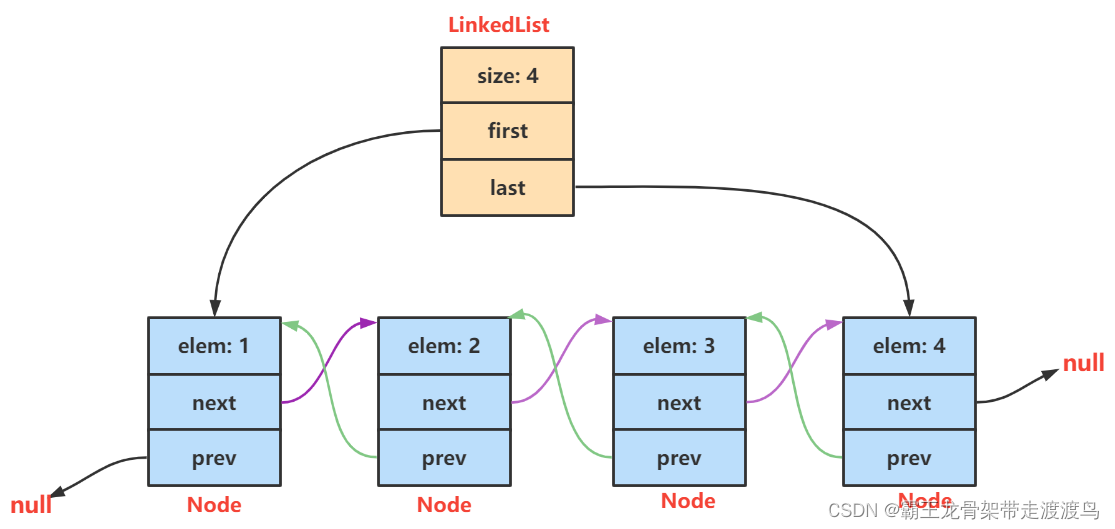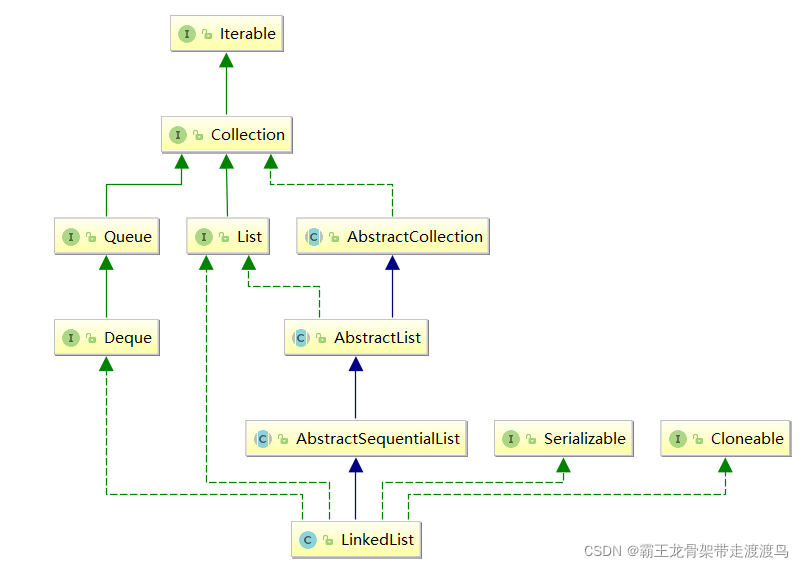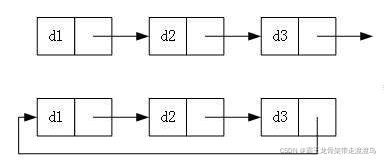目录
LinkedList
什么是LinkedList?
LinkedList的底层是双向链表结构,由于链表没有将元素存储在连续的空间中,元素存储在单独的节点中,然后通过引用将节点连接起来了,因此在在任意位置插入或者删除元素时,不需要搬移元素,效率比较高。
在集合框架中,LinkedList也实现了List接口,具体如下:
1. LinkedList实现了List接口
2. LinkedList的底层使用了双向链表
3. LinkedList没有实现RandomAccess接口,因此LinkedList不支持随机访问
4. LinkedList的任意位置插入和删除元素时效率比较高,时间复杂度为O(1)
LinkedList的使用
public static void main(String[] args) {
// 构造一个空的LinkedList
List<Integer> list1 = new LinkedList<>();
List<String> list2 = new java.util.ArrayList<>();
list2.add("JavaSE");
list2.add("JavaWeb");
list2.add("JavaEE");
// 使用ArrayList构造LinkedList
List<String> list3 = new LinkedList<>(list2);
}LinkedList的常用方法

链表
链表的概念
链表是一种物理存储结构上非连续存储结构,数据元素的逻辑顺序是通过链表中的引用链接次序实现的 。

1.单向或双向

2.带头或不带头

3.循环或非循环

无头单向非循环链表:结构简单,一般不会单独用来存数据。实际中更多是作为其他数据结构的子结构,如哈希桶、图的邻接表等等。另外这种结构在笔试面试中出现很多。
无头双向链表:在Java的集合框架库中LinkedList底层实现就是无头双向循环链表。
链表的实现
无头单向非循环链表的实现
import java.util.Stack;
class ListNode {
public int val;
public ListNode next;//类型是Node null
public ListNode(int val) {
this.val = val;
}
}
public class SingleLinkedList {
public ListNode head;//为什么定义到这里
public int usedSize;//记录当前链表中节点的个数
public void createList() {
ListNode node1 = new ListNode(12);
ListNode node2 = new ListNode(23);
ListNode node3 = new ListNode(34);
ListNode node4 = new ListNode(45);
ListNode node5 = new ListNode(56);
//int a = 10;
node1.next = node2;//?
node2.next = node3;
node3.next = node4;
node4.next = node5;
this.head = node1;
this.usedSize = 5;
}
/**
* 打印链表里面的元素
*/
public void myToString(){
ListNode cur = this.head;
while (cur != null) {
System.out.print(cur.val+" ");
cur = cur.next;
}
System.out.println();
}
/**
* 从指定的位置开始打印链表
* @param newHead
*/
public void myToString(ListNode newHead){
ListNode cur = newHead;
while (cur != null) {
System.out.print(cur.val+" ");
cur = cur.next;
}
System.out.println();
}
//查找是否包含关键字key是否在单链表当中
public boolean contains(int key){
ListNode cur = this.head;
while (cur != null) {
//equals
if(cur.val == key) {
return true;
}
cur = cur.next;
}
return false;
}
//得到单链表的长度-》尝试不用我们定义的usedSize
public int size(){
int count = 0;
ListNode cur = this.head;
while (cur != null) {
count++;
cur = cur.next;
}
return count;
}
public int size2(){
return this.usedSize;
}
//头插法
public void addFirst(int data) {
ListNode node = new ListNode(data);
if(head == null) {
head = node;
}else {
node.next = head;
head = node;
}
this.usedSize++;
}
//尾插法
public void addLast(int data){
ListNode node = new ListNode(data);
if(this.head == null) {
this.head = node;
}else {
ListNode cur = this.head;
while (cur.next != null) {
cur = cur.next;
}
//cur.next == null
cur.next = node;
}
this.usedSize++;
}
/**
* 查找Index-1位置的节点的地址
* @param index
* @return
*/
private ListNode searchIndex(int index) {
int count = 0;
ListNode cur = this.head;
while (count != index-1) {
cur = cur.next;
count++;
}
return cur;
}
//任意位置插入,第一个数据节点为0号下标
public void addIndex(int index,int data){
if(index < 0 || index > this.usedSize) {
throw new RuntimeException("index不合法!");
}
if(index == 0) {
addFirst(data);
return;
}
if(index == this.usedSize) {
addLast(data);
return;
}
ListNode listNode = new ListNode(data);
ListNode cur = searchIndex(index);
listNode.next = cur.next;
cur.next = listNode;
this.usedSize++;//这里注意 该加要加 该减要减
}
//删除第一次出现关键字为key的节点
public void remove(int key){
if(this.head == null) {
return;
}
if(this.head.val == key) {
this.head = this.head.next;
return;
}
ListNode prev = findPrevNode(key);
if(prev == null) {
throw new RuntimeException("不存在你要删除的节点!");
}
ListNode del = prev.next;
prev.next = del.next;
this.usedSize--;
}
/**
* 找到关键字Key的前一个节点
* @param key
* @return 不存在 返回null 存在返回节点的地址
*/
private ListNode findPrevNode(int key) {
ListNode prev = this.head;
while (prev.next != null) {
if(prev.next.val == key) {
return prev;
}
prev = prev.next;//????????
}
return null;
}
//删除所有值为key的节点
public void removeAllKey(int key){
if(this.head == null) return;
ListNode prev = this.head;
ListNode cur = this.head.next;
while (cur != null) {
if(cur.val == key) {
prev.next = cur.next;
cur = cur.next;
this.usedSize--;
}else {
prev = cur;
cur = cur.next;
}
}
if(this.head.val == key) {
this.head = this.head.next;
this.usedSize--;
}
}
/**
* 清空链表
*/
public void clear1(){
this.head = null;
this.usedSize = 0;
}
public void clear (){
ListNode cur = this.head;
while (cur != null) {
ListNode curNext = cur.next;
cur.next = null;
cur = curNext;
}
this.head = null;
this.usedSize = 0;
}
//shift+f6
public ListNode reverseList() {
if(this.head == null) {
return null;
}
if(this.head.next == null) {
return this.head;
}
//最起码有2个节点以上
ListNode cur = this.head.next;
this.head.next = null;
while (cur != null) {
ListNode curNext = cur.next;
cur.next = this.head;
this.head = cur;
cur = curNext;
}
return this.head;
}
/**
* 找到链表的中间节点
* @return
*/
public ListNode middleNode() {
ListNode fast = head;
ListNode slow = head;
while (fast != null && fast.next != null) {
fast = fast.next.next;
slow = slow.next;
}
return slow;
}
/**
* 找到单链表 倒数第K个节点
* 要去 只遍历链表一遍
* @param k
* @return
*/
public ListNode findKthToTail(int k) {
//k是否是合法的
if(k <= 0 || head == null) {
return null;
}
ListNode fast = head;
ListNode slow = head;
while (k-1 > 0) {
if(fast.next == null) {
return null;
}
fast = fast.next;
/*if(fast == null) {
return null;
}*/
k--;
}
while (fast.next != null) {
fast = fast.next;
slow = slow.next;
}
return slow;
}
/**
* 以X为基准 进行分割链表
* @param pHead
* @param x
* @return
*/
public ListNode partition(ListNode pHead, int x) {
// write code here
if(pHead == null) {
return null;
}
ListNode bs = null;
ListNode be = null;
ListNode as = null;
ListNode ae = null;
ListNode cur = pHead;
while (cur != null) {
if(cur.val < x) {
if(bs == null) {
bs = cur;
be = cur;
}else {
be.next = cur;
be = be.next;
}
}else {
//是不是第一次插入
if(as == null) {
as = cur;
ae = cur;
}else {
ae.next = cur;
ae = ae.next;
}
}
cur = cur.next;
}
if(bs == null) {
return as;
}
be.next = as;
//检查最后一段是不是有数据,如果有,那么我们需要进行把最后一个节点的next置为空,否则会出现死循环
if(as != null) {
ae.next = null;
}
return bs;
}
/**
* 判断链表是不是回文链表
* @return
*/
public boolean chkPalindrome() {
if(head == null) {
return true;
}
if(head.next == null) {
return true;
}
//1、找到中间节点
ListNode fast = head;
ListNode slow = head;
while(fast != null && fast.next != null) {
fast = fast.next.next;
slow = slow.next;
}
//2、slow已经到中间位置了,开始翻转
ListNode cur = slow.next;
while(cur != null) {
ListNode curNext = cur.next;
cur.next = slow;
slow = cur;
cur = curNext;
}
//3、slow已经到最后一个节点了,开始往回走
while(head != slow) {
if(head.val != slow.val) {
return false;
}
if(head.next == slow) {
return true;
}
head = head.next;
slow = slow.next;
}
return true;
}
/**
* 判断链表是否有环
* @param head
* @return
*/
public boolean hasCycle(ListNode head) {
ListNode fast = head;
ListNode slow = head;
while(fast != null && fast.next != null) {
fast = fast.next.next;
slow = slow.next;
if(fast == slow) {
return true;
}
}
//
return false;
}
/**
* 判断链表是否有环
* @param head
* @return
*/
public boolean hasCycle2(ListNode head) {
ListNode fast = head;
ListNode slow = head;
while(fast != null && fast.next != null) {
fast = fast.next.next;
slow = slow.next;
if(fast == slow) {
break;
}
}
if(fast == null || fast.next == null) {
return false;
}
return true;
}
/**
* 求环的入口点
* @param head
* @return
*/
public ListNode detectCycle(ListNode head) {
ListNode fast = head;
ListNode slow = head;
while(fast != null && fast.next != null) {
fast = fast.next.next;
slow = slow.next;
if(fast == slow) {
break;
}
}
if(fast == null || fast.next == null) {
return null;
}
fast = head;
while (fast != slow) {
fast = fast.next;
slow = slow.next;
}
return fast;
}
/**
* 递归逆序打印单链表
* @param head
*/
public void printList(ListNode head) {
if(head == null) {
return;
}
if(head.next == null) {
System.out.print(head.val+" ");
return;
}
printList(head.next);
System.out.print(head.val+" ");
}
public void printList2() {
Stack<ListNode> stack = new Stack<>();
ListNode cur = head;
while (cur != null) {
stack.push(cur);
cur = cur.next;
}
while (!stack.empty()) {
ListNode tmp = stack.pop();
System.out.print(tmp.val+" ");
}
System.out.println();
}
}
带头双向循环链表的实现
import java.awt.*;
class ListNode {
public int val;//值
public ListNode next;//后继信息
public ListNode prev;//前驱信息
public ListNode(int val) {
this.val = val;
}
}
public class MyLinkedList {
public ListNode head;//标记双向链表的头节点
public ListNode last;//标记双向链表的尾巴
//头插法
public void addFirst(int data){
ListNode node = new ListNode(data);
if(head == null) {
head = node;
last = node;
}else {
node.next = head;
head.prev = node;
head = node;
}
}
//尾插法
public void addLast(int data){
ListNode node = new ListNode(data);
if(head == null) {
head = node;
last = node;
}else {
last.next = node;
node.prev = last;
last = node;
}
}
//任意位置插入,第一个数据节点为0号下标
public void addIndex(int index,int data){
if(index < 0 || index > size()) {
throw new RuntimeException("index不合法!");
}
if(index == 0) {
addFirst(data);
return;
}
if(index == size()) {
addLast(data);
return;
}
ListNode node = new ListNode(data);
ListNode cur = findIndex(index);
node.next = cur;
cur.prev.next = node;
node.prev = cur.prev;
cur.prev = node;
}
private ListNode findIndex(int index) {
ListNode cur = this.head;
while (index != 0) {
cur = cur.next;
index--;
}
return cur;
}
//查找是否包含关键字key是否在单链表当中
public boolean contains(int key){
ListNode cur = this.head;
while (cur != null) {
if(cur.val == key) {
return true;
}
cur = cur.next;
}
return false;
}
//删除第一次出现关键字为key的节点
public void remove(int key){
ListNode cur = this.head;
while (cur != null) {
if(cur.val == key) {
//判断是不是头节点
if(cur == head) {
head = head.next;
//判断是不是只有1个节点
if(head != null) {
head.prev = null;
}
}else {
//两种情况:1、是中间节点 2、是尾巴节点
cur.prev.next = cur.next;
if(cur.next != null) {
//不是尾巴节点 是中间节点
cur.next.prev = cur.prev;
}else {
//尾巴节点
last = last.prev;
}
}
return;//删除结束 return走人
}else {
cur = cur.next;
}
}
}
//删除所有值为key的节点
public void removeAllKey(int key){
ListNode cur = this.head;
while (cur != null) {
if(cur.val == key) {
//判断是不是头节点
if(cur == head) {
head = head.next;
//判断是不是只有1个节点
if(head != null) {
head.prev = null;
}
}else {
//两种情况:1、是中间节点 2、是尾巴节点
cur.prev.next = cur.next;
if(cur.next != null) {
//不是尾巴节点 是中间节点
cur.next.prev = cur.prev;
}else {
//尾巴节点
last = last.prev;
}
}
}
cur = cur.next;
}
}
//得到单链表的长度
public int size(){
int count = 0;
ListNode cur = this.head;
while (cur != null) {
count++;
cur = cur.next;
}
return count;
}
public void display() {
ListNode cur = this.head;
while (cur != null) {
System.out.print(cur.val+" ");
cur = cur.next;
}
System.out.println();
}
public void clear(){
ListNode cur = head;
while (cur != null) {
ListNode curNext = cur.next;
//cur.val = null;
cur.prev = null;
cur.next = null;
cur = curNext;
}
head = null;
last = null;
}
}






















 342
342











 被折叠的 条评论
为什么被折叠?
被折叠的 条评论
为什么被折叠?








